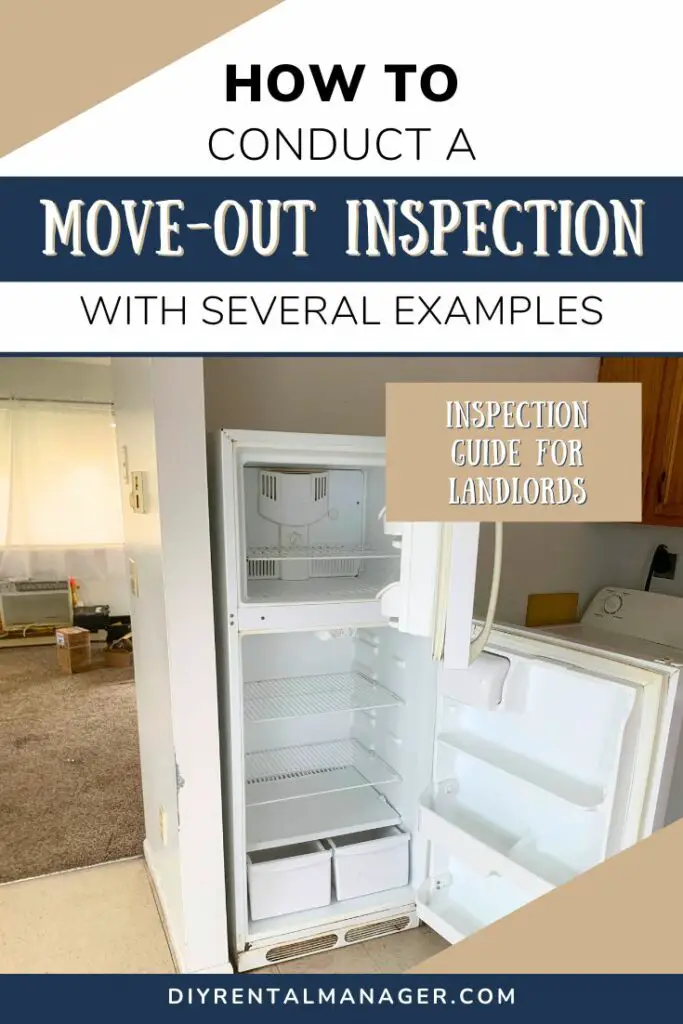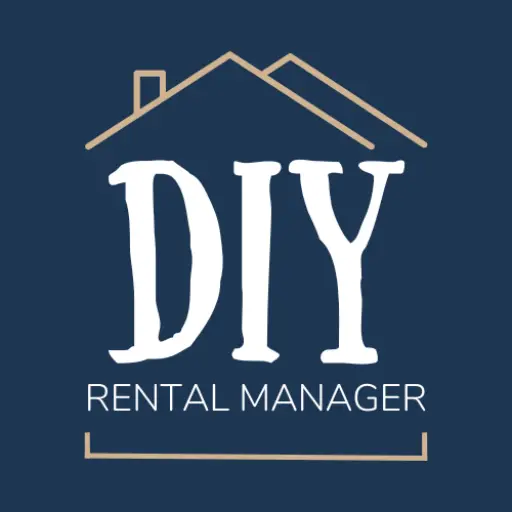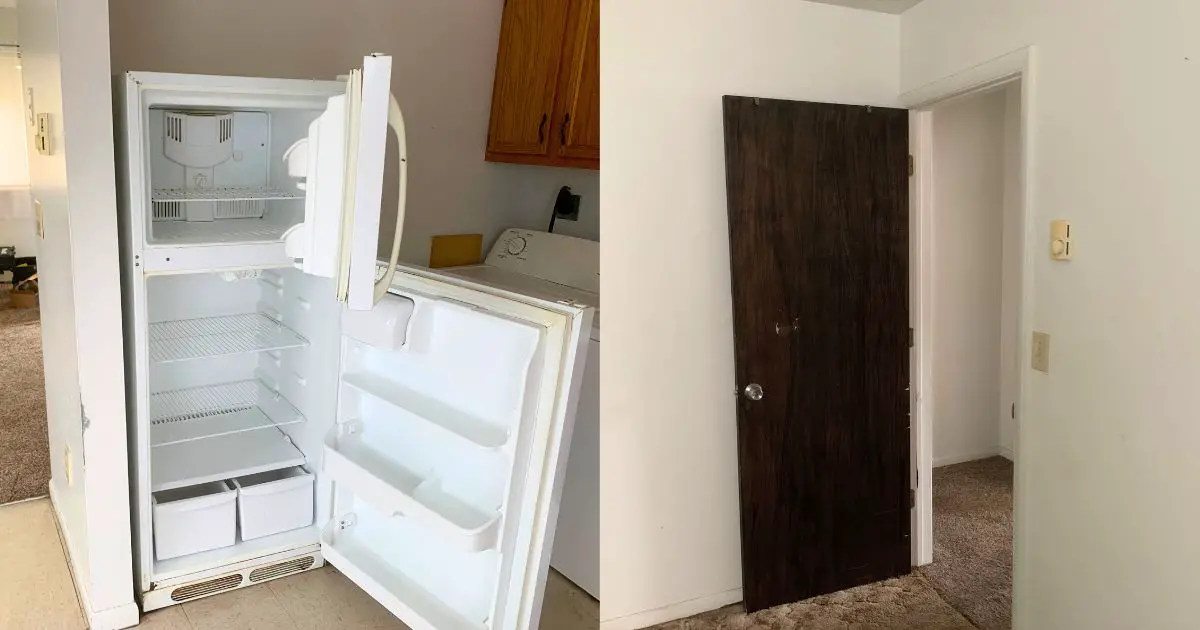A move-out inspection is a vital process that landlords should complete after a tenant moves out to document the condition of the property.
This is where you will not only protect yourself from any lawsuits regarding wrongful deductions from the security deposit, but you also will have the chance to assess what needs to be taken care of during the unit turnover process.
So, how do you do a move-out inspection?
To conduct a move-out inspection in a rental property, walk around the interior and exterior of the property taking full-room photos and close-up photos of any damages found. As damages are found, write down an explanation of the damages in a Move-Out Condition Report for your records.
With those main points in mind, I’ll cover everything you need to understand what a move-out inspection is, when to inspect the rental home, and how to thoroughly inspect the rental property below.
Let’s dive in!
Quick Navigation
- What Is A Move-Out Inspection For A Rental Property?
- What Is Considered Normal Wear And Tear In A Rental Property?
- Benefits Of Doing A Move-Out Inspection In A Rental Property
- When To Do A Move-Out Inspection In A Rental Property?
- How To Do A Move-Out Inspection In A Rental Property
- Supply The Tenant With A Move-Out Checklist (Before The Tenant Moving Out)
- Print Off A Move-Out Condition Report To Fill Out
- Inspect Each Room Of The Rental Property & Take Photos (After The Tenant Has Moved Out)
- What To Look For During A Rental Inspection In The Living Room
- What To Look For During A Rental Inspection In The Kitchen
- What To Look For During A Rental Inspection In Each Bathroom
- What To Look For During A Rental Inspection In Each Bedroom
- What To Look For During A Rental Inspection In The Basement
- What To Look For During A Rental Inspection On The Exterior Of The Building
- Final Thoughts
- Related Content
1. What Is A Move-Out Inspection For A Rental Property?
A move-out inspection is a process where a landlord inspects each room in a rental property after a tenant has moved out for damage beyond normal wear and tear. Any damage found beyond normal wear and tear during a move-out inspection can be deducted from the security deposit prior to returning it to the tenant.
2. What Is Considered Normal Wear And Tear In A Rental Property?
Normal wear and tear include any damages from regular use over the years. Some common normal wear and tear items include:
- Old carpet that needs to be replaced because it has been used for 10+ years
- Old cabinets that need to be replaced because they are wearing down after 15+ years of regular use
- Tile grout that has been broken out from 10+ years of regular use
- Appliances that have been in use for 10+ years and aren’t working consistently/to their full potential anymore
- Small dings or chips out of trim, baseboard, doors, cabinets, etc that naturally occur from 10+ years of regular use
- Faucets that are hard to turn on and off after 15+ years of use and lime build-up
- Anything that has exceeded its useful life and is not a result of misuse of the item is considered normal wear and tear and should not be deducted from the security deposit
Items that are not considered normal wear and tear include:
- Mold (from living conditions – never using the ceiling vent, leaving wet towels on the floor for long periods of time, etc)
- Leaks from misuse or neglect (drain lines knocked loose, etc)
- Broken faucets or handles
- Broken windows, blinds, doors, glass, locks, or any other damage caused directly or indirectly by the tenant or their guests
- Burnt out light bulbs and/or dead batteries in the smoke/carbon monoxide detectors (these are tenant repairs they are responsible for replacing regularly)
- Clogged toilets, bathtubs, sinks, and other drains
- Anything that is broken or damaged from misuse or neglect is considered damage that can be deducted from the security deposit
3. Benefits Of Doing A Move-Out Inspection In A Rental Property
There are several benefits to doing a move-out inspection in a rental property. Some of these benefits include:
- Provides clear documentation of the condition of the property when the tenant moves out which can help support any arguments from the tenant or protect you from any lawsuits in court (especially if photos are taken clearly showing any damages that result in a deduction from the security deposit)
- Makes it much more clear what should and should not be deducted from the security deposit
- Creates a list of items that need to be repaired or replaced during the unit turnover process to get the home ready for the next tenant
Prior to doing a move-out inspection, we would typically give the full security deposit back to avoid any conflicts and just eat the cost of the repairs ourselves. That was problematic because it put no accountability on the tenant to leave the property in the condition it was given to them.
Now, we inspect and document the property so we can deduct any necessary repairs from the security deposit with proof, and we can start to pinpoint what areas of the property need repairs and further cleaning. It’s a professional way to close out a tenancy.
4. When To Do A Move-Out Inspection In A Rental Property?
A move-out inspection should be completed after a tenant has completed their Move-Out Checklist*, fully moved out of the property, and handed over the keys officially ending their tenancy. Ideally, move-out inspections happen within hours of the tenant vacating the property.
*When the tenant gives their notice that they plan to leave the property, it’s best practice to supply them with a Move-Out Checklist that they can follow to help them return the property in the condition that you are expecting.
How we like to do it is we agree with the tenant on a day that they can be fully out of the home and tell them to leave all keys (and any copies they made, if any) on the kitchen countertop inside the home.
Then, we confirm with them that they’ve left the property, and we drive over to collect the keys, change the electronic door codes, inspect the property, and take photos of the entire property.
Does The Tenant Have To Be Present For The Final Inspection Of The Rental Property?
Tenants do not have to be present for the final inspection of the rental property, though they can be if they wish to review the property with you. Thorough documentation of the condition of the property through written notes and photos should be taken regardless of whether the tenant is present or not to provide proof of any damage and any deductions from the security deposit resulting from said damages.
We prefer that the tenants are not present so we can thoroughly inspect the property and take photos without them influencing our decisions. (Some tenants will linger and argue with you on every damaged spot that it “wasn’t them”. We would prefer to not be put on the spot for those types of conversations until after we’ve determined what is normal wear and tear and what is not.)
After we have all of the photos and a list of items that are deductible, we then send an email to the tenant explaining the deductions and any photos that need to go with that as proof.
Including the photos and breakdown of charges via email also gives you proper documentation of the conversation you’ve had with the tenant. It’s a fail-safe way to communicate so there can never be any “he said, she said” arguments. The full conversation is documented in writing.
5. How To Do A Move-Out Inspection In A Rental Property
Move-out inspections are relatively easy to complete once you know what to look for. If you follow the list below, you’ll be able to successfully walk a property and check for damages like a pro.
I. Supply The Tenant With A Move-Out Checklist (Prior To The Tenant Moving Out)
Before we can dive into what to inspect within each room, we need to discuss the Move-Out Checklist.
A Move-Out Checklist is a list of actions you want the tenant to complete prior to them moving out to help return the property to the original condition they received it in. These checklists often include:
- Cleaning instructions by room (wiping down/dusting everything in each room)
- Small repairs they are expected to complete prior to leaving (such as spackling nail holes, replacing light bulbs and smoke detector batteries, changing furnace filters, etc.)
- Other general instructions (returning their keys and garage door openers, removing all personal property and trash, etc)
This checklist should be supplied as soon as the tenant says they are going to move out (at least 20-30 days before the tenant moves out), so they have time to complete all of the items on the checklist. For more information on what to include in a Tenant Move-Out Packet, check out my other article.
When this checklist is supplied, it encourages tenants to help return the property in better condition and helps them understand what they need to do to receive their full security deposit back (or why they won’t receive the full amount back if they don’t follow the checklist).
II. Print Off A Move-Out Condition Report To Fill Out
Now, it’s time to print off the Move-Out Condition Report, so you can fill it out as you inspect the property.
If you followed my smooth lease signing process guide when placing this tenant, then you already have a Move-In Move-Out Condition Report partially filled out from the lease signing. Now is the time to print off the copy of that document, so you can review the “move-in” portion and fill out the “move-out” portion of the report as you inspect the property.
However, if you don’t have a report already partially filled out from when the tenant moved in, then you can still create and print out a new copy, so you can document how the home was returned to you.
Below, I’ve listed many of the items you should be inspecting in each room to help you understand what should be in a Move-Out Condition Report.
III. Inspect Each Room Of The Rental Property & Take Photos (After The Tenant Has Moved Out)
After the tenant officially moves out, it’s time to inspect each room of the rental property and take tons of photos.
As you walk from room to room, start by taking photos of the full room from each corner of the room. (Use the same photography ideas I explained in my article about how to take photos for a listing, so you can compare the room from the same angles as the original move-in photos.)
Then, check out each item in the Move-Out Condition Report and take close-up photos of any of the items that have damage on them (specifically if they were not documented during the Move-In inspection).
In general, we like to check each room for the following:
- Inspect the refrigerator, stove, dishwasher, garbage disposal, microwave, A/C, furnace or baseboard heaters, and hot water heater to make sure each works properly
- Check to see if the furnace filter(s) were replaced
- Check for leaks under the sinks (run water in all sinks/shower for 5-10 min)
- Flush the toilet(s) and run water in the shower/bathtub
- Check that all light bulbs and smoke/carbon monoxide detector batteries were replaced
- Check the ceiling in all rooms for any signs of leaks
- Look for infestations of bugs (ants, mud tracks from termites, etc) around doors, windows, and in the kitchen
- Take detailed pictures of every room, inside cabinets and closets, and all appliances (up close, inside and out) for our records (take pictures specifically of anything that is broken or damaged)
We know if we check these specific areas, we will find the majority of the damages and problems within the rental home. In our report, though, it’s best to break out each room so you can write detailed notes on anything that is damaged or not working properly.
What To Look For During A Rental Inspection In The Living Room
Some of the items we inspect in the living room of a rental property include:
| Item To Inspect | Condition |
|---|---|
| Floors | (Write the condition of the item here for your records.) |
| Walls and ceiling | |
| Windows | |
| Window coverings (blinds, etc) | |
| Light fixtures and fans | |
| Doors and door hardware | |
| Heating and cooling | |
| Outlets and switches | |
| Smoke alarms and carbon monoxide detectors | |
| Other |
In the living room, we mostly look for holes in the carpet or walls, stains on anything, broken blinds, all of the doors, outlets, switches, smoke and CO detectors work, and anything else that seems damaged or not working.
What To Look For During A Rental Inspection In The Kitchen
Some of the items we inspect in the kitchen of a rental property include:
| Item To Inspect | Condition |
|---|---|
| Floors | (Write the condition of the item here for your records.) |
| Walls and ceiling | |
| Windows | |
| Window coverings (blinds, etc) | |
| Light fixtures and fans | |
| Doors and door hardware | |
| Heating | |
| Outlets and switches | |
| Smoke alarms and carbon monoxide detectors | |
| Cabinets and cabinet hardware | |
| Countertops and caulking | |
| Refrigerator | |
| Stove/oven | |
| Stove vent | |
| Microwave | |
| Dishwasher | |
| Sink/fixtures/plumbing | |
| Garbage disposal | |
| Washer/dryer | |
| Other |
In the kitchen, we mostly look for damaged or broken cabinets or countertops, leaks and/or damaged plumbing under the sink, damage to the flooring or walls, stains on anything, broken blinds, all of the doors, outlets, switches, smoke and CO detectors work, all of the appliances work and look to be in good condition still, and anything else that seems damaged or not working.
We also look for signs of insect or rodent infestations: mud tracks, crumbs of food or sawdust in random places, mouse droppings, etc.
What To Look For During A Rental Inspection In Each Bathroom
Some of the items we inspect in each bathroom of a rental property include:
| Item To Inspect | Condition |
|---|---|
| Floors | (Write the condition of the item here for your records.) |
| Walls and ceiling | |
| Windows | |
| Window coverings (blinds, etc) | |
| Light fixtures and fans | |
| Doors and door hardware | |
| Heating | |
| Outlets and switches | |
| Smoke alarms and carbon monoxide detectors | |
| Cabinets and cabinet hardware | |
| Countertop and caulking | |
| Sink/fixtures/plumbing | |
| Bathtub/shower/fixtures | |
| Toilet | |
| Other |
In the bathrooms, we mostly look for similar things to the kitchen: damaged or broken cabinets or countertops, leaks and/or damaged plumbing under the sink, damage to the flooring or walls, stains on anything, broken blinds, all of the doors, outlets, switches, smoke and CO detectors work, the toilet flushes properly, the bathtub or shower works properly, is caulked well, and looks to be in good condition still, and anything else that seems damaged or not working.
What To Look For During A Rental Inspection In Each Bedroom
Some of the items we inspect in each bedroom of a rental property include:
| Item To Inspect | Condition |
|---|---|
| Floors | (Write the condition of the item here for your records.) |
| Walls and ceiling | |
| Windows | |
| Window coverings (blinds, etc) | |
| Light fixtures and fans | |
| Doors and door hardware | |
| Heating | |
| Outlets and switches | |
| Smoke alarms and carbon monoxide detectors | |
| Closet | |
| Other |
In the bedrooms, we mostly look for the same things we look for in the living room: holes in the carpet or walls, stains on anything, broken blinds, all of the doors, outlets, switches, smoke and CO detectors work, and anything else that seems damaged or not working.
What To Look For During A Rental Inspection In The Basement
Some of the items we inspect in the basement of a rental property include:
| Item To Inspect | Condition |
|---|---|
| Floors | (Write the condition of the item here for your records.) |
| Walls and ceiling | |
| Windows | |
| Window coverings (blinds, etc) | |
| Light fixtures and fans | |
| Doors and door hardware | |
| Heating | |
| Outlets and switches | |
| Smoke alarms and carbon monoxide detectors | |
| Sink/fixtures/plumbing | |
| Washer/Dryer | |
| Dryer vent | |
| Other |
In the basement, we mostly look for signs of mold, leaks/damage to the plumbing, the furnace and hot water heater are working and still in good condition, and anything else that seems damaged or not working.
What To Look For During A Rental Inspection On The Exterior Of The Building
Some of the items we inspect on the exterior of a rental property include:
| Item To Inspect | Condition |
|---|---|
| Roof/Gutters | (Write the condition of the item here for your records.) |
| Siding/Windows | |
| Light fixtures and fans | |
| Doors and door hardware | |
| Steps/Railings | |
| Garage/Carport | |
| Lawn/Yard | |
| Porch/Patio | |
| Driveways/Walkways | |
| Other |
On the exterior of the property, we mostly look for signs of roof, gutter, window, or siding damage, broken steps or railings, anything blocking the driveway or walkways, and anything else that seems damaged or not working.
Final Thoughts
That’s it! By now, you have a good understanding of what a Move-Out Condition Report is and how to conduct a move-out inspection. Now, all that’s left to do is inspect the property and return the remainder of the security deposit!
You’ll also be able to start preparing your rental property for the next tenant.
We’ve found that by taking the time to document the condition of the property thoroughly, we get fewer arguments about what has been deducted from the security deposit since we were clear upfront and have proof through photos. This ultimately helps us transition from one tenant to the next faster without much headache.
I hope you find this article useful and that it helps you inspect your rental property even if you’ve never inspected one before!
Catch you in my next post!
Related Content
Check out my recommended tools, templates, and resources to free up your time from constantly working on and worrying about your rental properties. My husband and I use these tools to self-manage 18 rental units (and counting) for only 5-10 hours a month.
Keep in mind that most of these items are either free or reasonably priced for the amount of value that they provide. My goal on this page is to recommend tools, templates, and resources that we use daily and wish we had known about at the beginning of our landlord journey. Since implementing them, they’ve saved us countless hours and tons of headaches.
Related Content
Check out my recommended tools, templates, and resources to free up your time from constantly working on and worrying about your rental properties. My husband and I use these tools to self-manage 18 rental units (and counting) for only 5-10 hours a month.
Keep in mind that most of these items are either free or reasonably priced for the amount of value that they provide. My goal on this page is to recommend tools, templates, and resources that we use daily and wish we had known about at the beginning of our landlord journey. Since implementing them, they’ve saved us countless hours and tons of headaches.
Finding good tenants for a rental property is arguably one of the most essential tasks that a self-managing landlord must accomplish. You’re searching for a high-quality tenant that will pay on time, take care of the property, and be easy to communicate with all while trying to get the most amount of rent and filling the vacant unit as quickly as possible.
That’s no small feat! So, how can you find good tenants for your rental property?


By Christine
Christine is a blogger and real estate investor/property manager who self-manages 18 rental units (and counting) alongside her husband, Adam. Although she successfully automates the management of her rentals and pockets the property management fee now, her path to success was not easy.
Go here to read her story, “From An Overwhelmed First-Time Landlord To A Pro Investor Self-Managing 18 Rentals On Less Than 10 Hours Per Month“.
Recent Posts
How To Reject A Tenant Application (With Examples!)
When you start to accept applications for your rental property, you’ll inevitably get some applications that do not meet your minimum screening standards (even if you list them in the listing, some people just don’t read or don’t care). When this happens, you’ll have to carefully review the application and send back a Tenant Application…
How To Write A New Tenant Welcome Letter For Your Rental Property
When we have found a new tenant that we are ready to sign a lease with, we want to start the new relationship off on the best terms possible. In order to do that, we need to ensure that they are familiar with the most important details of the lease. We do this by providing…
Ultimate Guide To Collecting Rent And Charging Late Fees As A Landlord (Easy System!)
Collecting rent from tenants is one of the most time-consuming (and emotionally charged) parts of being a landlord. Not only will you get every excuse under the sun about why rent will be late this month (again), but you will also miss out on opportunities to collect extra income and increase rent over time if…

By Christine
Christine is a blogger and real estate investor/property manager who self-manages 18 rental units (and counting) alongside her husband, Adam. Although she successfully automates the management of her rentals and pockets the property management fee now, her path to success was not easy.
Go here to read her story, “From An Overwhelmed First-Time Landlord To A Pro Investor Self-Managing 18 Rentals On Less Than 10 Hours Per Month“.
Recent Posts
How To Reject A Tenant Application (With Examples!)
When you start to accept applications for your rental property, you’ll inevitably get some applications that do not meet your minimum screening standards (even if you list them in the listing, some people just don’t read or don’t care). When this happens, you’ll have to carefully review the application and send back a Tenant Application…
How To Write A New Tenant Welcome Letter For Your Rental Property
When we have found a new tenant that we are ready to sign a lease with, we want to start the new relationship off on the best terms possible. In order to do that, we need to ensure that they are familiar with the most important details of the lease. We do this by providing…
Ultimate Guide To Collecting Rent And Charging Late Fees As A Landlord (Easy System!)
Collecting rent from tenants is one of the most time-consuming (and emotionally charged) parts of being a landlord. Not only will you get every excuse under the sun about why rent will be late this month (again), but you will also miss out on opportunities to collect extra income and increase rent over time if…





